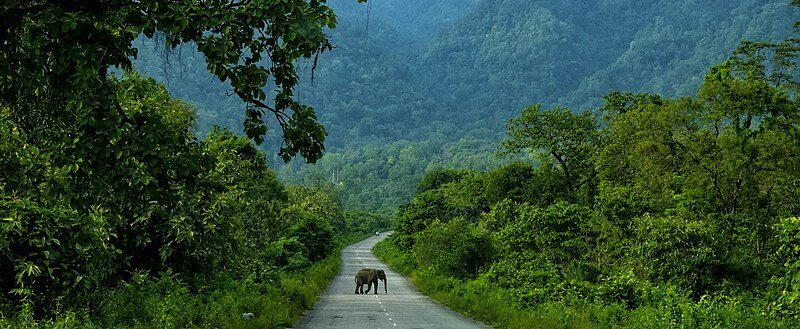





Copyright infringement not intended
Picture Courtesy: https://india.mongabay.com/2024/04/explainer-what-are-wildlife-corridors/
Context: The planned translocation of tigers from Tadoba-Andhari Tiger Reserve (TATR) to Sahyadri Tiger Reserve (STR) in Maharashtra highlights the importance of wildlife corridors, specifically the Sahyadri-Konkan corridor, in tiger conservation efforts.
Wildlife Corridors
|
Sahyadri Tiger Reserve |
●The Sahyadri Tiger Reserve situated in the Sahyadri Ranges of the Western Ghats in Maharashtra. ●It is located within the Sahyadri Ranges, which serve as the boundary between Maharashtra, Karnataka, and Goa. ●The reserve spans over two protected areas: Koyna Wildlife Sanctuary (KWLS) and Chandoli National Park (CNP). ●The reserve comprises woodlands, grasslands, and plateaus (locally known as "Sadaa"), which are lateritic in nature. ●The area supports a variety of vegetation including fodder species like karvi, bamboo, kumbal, and fruit-bearing species like Zizyphus rugosa, Ficus racemosa, Sideroxylon tomentasa, etc. ●Flora Types: ○Western (Montane) Subtropical Hill Forests ○West Coast Semi-evergreen Forests ○Southern Moist Mixed Deciduous Forests ●The reserve is home to a diverse range of wildlife, including: ○Top carnivores like Tiger, Wild Dog, and Leopard. ○Herbivores like Gaur, Sambar, Four Horned Antelope, Mouse Deer, and Giant Squirrel. ○Various bird species including Hornbills and Indian River Tern. ○Reptiles like Vultures, Crocodiles, and snakes. ○Endangered species like the Blue finned Mahseer fish and butterflies. |
|
Tadoba Andhari Tiger Reserve |
●The Tadoba Andhari Tiger Reserve, located in the Chandrapur district of Maharashtra. ●The reserve includes both Tadoba National Park and Andhari Wildlife Sanctuary. ●"Tadoba" is derived from the name of the local god worshipped by tribes in the region, while "Andhari" refers to the Andhari River flowing through the forest. ●The reserve encompasses diverse landscapes including forested hills, meadows, valleys, and wetlands like Tadoba Lake and Kolsa Lake. ●Predominantly southern tropical dry deciduous forest. ●Teak is predominant, along with crocodile bark, bija, dhauda, hald, salai, semal, tendu, beheda, hirda, and others. ●Bengal tigers are the main attraction, with around 88 individual tigers recorded within the reserve using SECR methodology. Indian leopards, sloth bears, gaur, nilgai, dhole, small Indian civet, jungle cats, sambar, chital, and more. ●Marsh crocodiles, Indian python, Indian monitor, terrapins, Indian star tortoise, Indian cobra, Russel's vipers, and others. ●Bird species recorded, including raptors like grey-headed fish eagle, crested serpent eagle, changeable hawk-eagle, and various other species like Indian peafowl, orange-headed thrush, Indian pitta, and more. |
Importance of Corridors for Tiger Conservation
Gene Flow and Genetic Diversity
Facilitating Tiger Movements
Guarding Against Fragmentation
Mitigating Human-Wildlife Conflict
Sahyadri-Konkan Corridor and Tiger Conservation
Collaboration and Conservation Strategies
Conclusion
Source:
|
PRACTICE QUESTION Q. Evaluate the role of wildlife corridors in facilitating gene flow and maintaining genetic diversity among spatially separated populations of various species. Discuss the potential consequences of reduced genetic diversity on long-term population viability and adaptability to environmental changes. |











© 2025 iasgyan. All right reserved